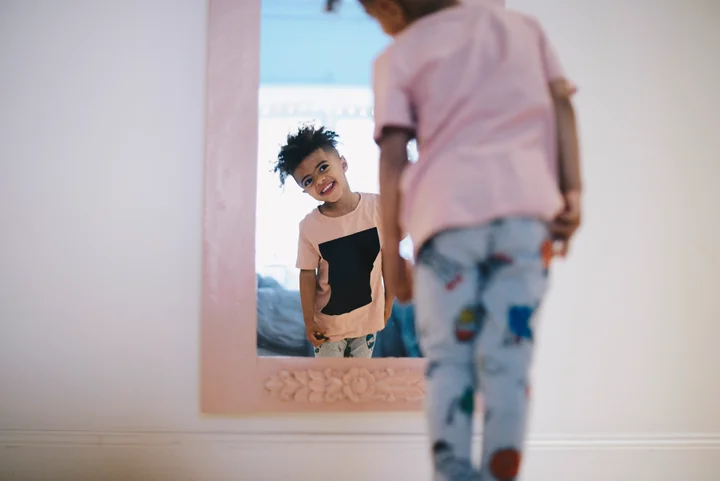GreatSchools issued the following announcement on Sep. 27.
When it comes to a child’s body image, it should come as no surprise that parents play a major role. The research ― and countless personal essays ― back this up.
“Parents influence how their children come to think about their bodies in a number of ways. These include the feelings, attitudes and conversations that parents have about their own bodies and appearance ― also, comments from parents about their child’s body and appearance,” said Amy Slater, an associate professor at the Centre for Appearance Research at the University of the West of England, Bristol.
Of course, there are other important societal factors at play, but parents can be a crucial source of positive or negative messaging from a young age.
“It is vital that we try to develop positive body image in our children, as we know that positive body image is associated with higher self-esteem and healthy behaviors, whereas negative body image is associated with a wide range of negative outcomes, including lowered self-esteem, depression, disordered eating, poorer academic achievement, and lowered engagement in healthy behaviors,” Slater explained.
RAISE THE KIND OF PERSON YOU'D LIKE TO KNOWSubscribe to our parenting newsletter.Thanks!You have been successfully signed up.
To help prevent those negative outcomes, HuffPost spoke to Slater and other experts to identify everyday ways parents can foster healthy body image in kids:
1. Banish Negative Body Talk
“Children learn how they should think and feel about their own bodies from listening to the adults around them,” said Renee Engeln, a professor of psychology at Northwestern University and the author of Beauty Sick: How the Cultural Obsession With Appearance Hurts Girls and Women. “If they hear adults engaging in negative body talk ― always focusing on ‘problematic’ body areas ― kids get the impression that bodies can never be good enough as they are. If they hear adults disparaging other people’s bodies, they learn to apply that same sort of criticism to themselves when they look in the mirror.”
While it’s almost inevitable for children to absorb negative body talk from peers and other adults in their lives, parents have the power to combat these harmful messages by banishing this kind of communication at home.
Parents should be mindful of the way they communicate about weight and body size with and in front of their children and refrain from making disparaging comments about bodies, which sends the message that personal value stems from physical appearance.
2. Stop Criticizing Your Own Body
Not only should parents stop speaking negatively about others’ bodies, but they should also do the same about their own. Slater advised parents to be aware of their attitudes and beliefs about bodies and appearance.
“Try to avoid making any negative judgments and comments about your own body,” she said, offering “I’m so fat” or “I don’t have the ‘right’ body to wear X” as examples.
“Think specifically about how we communicate with our children and in front of our children about our own weight or physical appearance,” said Rebecca Puhl, a professor in the department of human development and family sciences and the deputy director for the Rudd Center for Food Policy & Obesity at the University of Connecticut.
“As parents, we need to communicate respect for people of diverse body sizes,” she continued. “This means working on our own body image and feeling comfortable with our own bodies as well and being mindful of how we express these feelings to our children.”
Parents need to refrain from fixating on weight and engaging in negative body talk — about others and themselves.
3. Share Positive Body Messages
Just as it’s important to stop negative body talk, it’s also helpful to replace those harmful messages with positive ones.
“As parents, we need to give ourselves and our children permission to feel good about themselves, regardless of their body shape or size or physical appearance,” said Puhl.
“As I remind my daughter often, ‘All bodies ― including yours ― are good bodies,’” said Joslyn Smith, a policy and communications associate at the National Eating Disorders Association.
4. Emphasize Other Values
Engeln suggested committing to having a “body talk free” household, which shows children there are much more important things to discuss than how we look or how other people look.
“When you shut down all that body talk, you leave room for healthier, more affirming and more interesting conversations,” she said. “You also send your children the message that what matters is not how people appear but what they do and what they say.”
Slater echoed this sentiment, saying that parents should emphasize other qualities. “Encourage valuing aspects of self that are not related to appearance, like being a good friend,” she said.
5. Focus On What Bodies Do
“Teach children to appreciate bodies for what they can do rather than how they look,” said Slater. “You can model this by valuing and respecting your own body for all the amazing things it does.”
Instead of discussing weight or shape, talk to kids about what their bodies are capable of and how they feel, not how they look.
“When my daughter says things to me like, ‘My belly is getting big,’ or ‘Mommy, you’re fat,’ I tell her she’s right. She’s growing, and her belly is getting bigger, and I self-identify as fat,” Smith said. “[I say] that it’s so cool she’s noticing how she’s growing and getting older and stronger, that bodies come in all different shapes and sizes and are almost always changing in some way, that some bodies are able to do things other bodies aren’t and that every single person’s body is equally good and valuable.”
6. Model Healthy Behaviors
“Some parents may be worried about their child’s eating behaviors or sedentary activity. But communicating these worries as critical comments about weight or appearance can be harmful and can backfire,” Puhl explained.
Instead, kids are more likely to eat nutritiously and engage in physical activity if parents foster a home environment that makes these behaviors accessible and inclusive of the whole family.
“All parents want their children to be healthy, but this is more likely to happen if parents model the healthy behaviors they want to see in their children,” she added.
7. Be Aware Of Food And Fitness Talk
Rather than use weight as a peg, parents can encourage healthy habits by avoiding that topic.
“Focus on how exercise is great for keeping your body flexible and strong ― and that it’s a fun stress reliever. Focus on teaching your children to listen to their bodies’ own cues about hunger and satiety,” said Engeln. “Teach them to be intuitive eaters instead of sending the message that some foods are good and some foods are bad.”
The ways in which parents talk about food, health and physical activity can be just as critical to the development of a child’s body image as direct discussion of weight and shape.
Teach children to appreciate bodies for what they can do rather than how they look,” said Slater.
“Because our eating and exercise patterns affect our mental health, developing a positive body image also requires a relaxed, open attitude to these issues. For example, parents can encourage children to enjoy a diverse range of foods and help them be able to navigate choices and celebrations involving, sometimes, food without it impacting on their self-worth,” said Laura Hart, a psychology and public health research fellow at La Trobe University in Australia and an author of the Confident Body, Confident Child study.
“If parents can find ways to enjoy being physically active with their kids without mentioning weight, this can help children to enjoy lifelong healthy movement without feeling guilty or ashamed about it,” she added.
8. Call Out Others
It’s not enough to simply stop negative body talk in your home. There may be situations when others in a child’s life promote these harmful messages.
“Point out examples of weight stigma or fat-shaming that you see, and explain to your child why shaming or stigmatizing people about their body is unacceptable and should not be tolerated,” Puhl said. “Do not allow family members to engage in weight-based teasing or negative comments about other people’s bodies or physical characteristics.”
9. Be Mindful Of Media
Outside the home, children are bombarded with messages from mass media and the fashion and diet industries that emphasize extreme ideals of thinness and buffness.
“Think about the media messages that their children are exposed to. What media are they consuming? What messages about bodies and appearance do these media promote?” said Slater. “Try to encourage media that promotes diverse appearances and that do not focus solely on beauty and appearance.”
There are many body-positive books for children, including Your Body Is Brilliant by Sigrun Danielsdottir and What I Like About Me! by Allia Zobel Nolan. Slater also recommended online resources like the Confident Body, Confident Child website.
10. Promote Diversity
Modeling healthy body esteem in front of your child involves showing respect for yourself and for others, regardless of how they look, said Puhl. “Point out to your child people of diverse body sizes who are successful, kind, athletic, ambitious, talented, leaders or helping their communities,” she advised.
These kinds of habits will teach children to value diversity by appreciating the many ways people can look.
“Practicing nonjudgment of others and ourselves is not easy. It takes practice. After all, we certainly aren’t socialized to be accepting or appreciative of all the different forms bodies take,” said Smith. “But I’m hopeful that if we start with rewiring our own brains to appreciate bodies, in all the ways they show up, and make sure that what we model that acceptance of others and self for our children, we can raise children to embrace all bodies and help build a more inclusive world, one where they know they are welcome as they are and take the initiative to welcome others.”
Original source can be found here.

Source: GreatSchools

 Alerts Sign-up
Alerts Sign-up